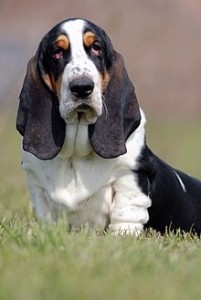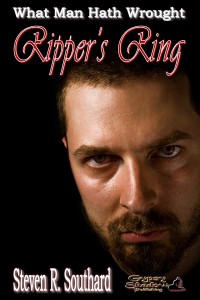There’s a basset hound in my upcoming story “Ripper’s Ring.” Let me tell you about him.
His name is Diogenes, and I’ve described him as having a copper-and-black mottled coat, a white blaze down his snout, and a white-tipped tail. He’s a pet, owned by my one of the story’s main characters, Detective Wellington Thales Bentbow.
 Diogenes is not quite like the hound pictured here, but you get the general idea of their characteristic wrinkled, sagging skin and drooping ears, giving them a perpetually depressed countenance.
Diogenes is not quite like the hound pictured here, but you get the general idea of their characteristic wrinkled, sagging skin and drooping ears, giving them a perpetually depressed countenance.
I chose a basset for my story for a couple of reasons. From the time my wife was growing up until a few years after I met her, her family kept pet Basset Hounds, owning as many as three at a time. They remain one of her favorite animals.
Second, I discovered Basset Hounds possess a sense of smell for tracking that’s the second keenest of all dog breeds, behind only the bloodhound. That makes this breed a good dog for a detective to own.
Especially a detective like Wellington Bentbow, who is philosophical by nature, a loner, and probably a bit wrinkly and gloomy himself. He’s come to regret purchasing Diogenes, though, because the hound much prefers sleeping to any sort of detective work.
Bentbow chose the name Diogenes for his pet because of the ancient Greek philosopher. Diogenes of Sinope has become associated with dogs. In addition, Diogenes would wander around in the daytime holding a lamp before him. When asked why, he said he was looking for an honest man. (How he planned to detect honesty using a lamp was, I believe, part of his little joke.) But this idea of tracking down a particular man also played into the choice of name for my basset hound character.
In a future post I’ll blog about the uses of pets in fiction, but for now I’ll say there’s a danger involved when you introduce familiar pets in your stories. In particular, dogs and cats are endearing to readers and it’s so tempting to provide details about the animal’s cute behavior and personality, they can steal the show if you’re not careful. I had to fight to keep Diogenes a minor character, because he could have taken over the story.
 “Ripper’s Ring” takes place in London in 1888, and basset-type hounds were then new to England, having only recently been imported from France. The modern Basset Hound (capitalized) didn’t become a standardized breed until after the time of my story, so strictly speaking, Diogenes would be categorized as a basset-type hound.
“Ripper’s Ring” takes place in London in 1888, and basset-type hounds were then new to England, having only recently been imported from France. The modern Basset Hound (capitalized) didn’t become a standardized breed until after the time of my story, so strictly speaking, Diogenes would be categorized as a basset-type hound.
You can read all about Diogenes in my story, “Ripper’s Ring,” due to launch on Monday, May 4th. If you own a Basset Hound that matches my description of Diogenes, I’ll be happy to post a picture of it, if you’ve taken the picture and give permission for posting it by leaving a comment for—
Poseidon’s Scribe
